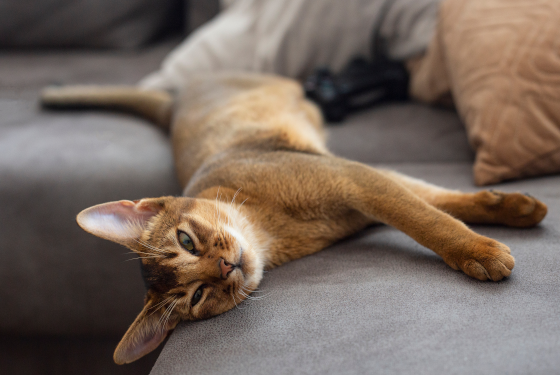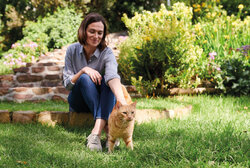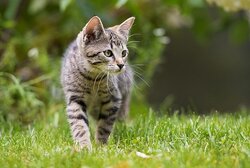The Burmese cat
The Burmese is a very energetic, curious and playful breed of cat. It loves action and plenty of variety, which is why things can get quite turbulent in its home.
Profile of the Burmese cat
- Size medium
- Weight female: approx. 4 kg, male: approx. 5 kg
- Origin Myanmar (Burma)
- Build strong, compact
- Length of fur short
- Colour of fur from cream to black
- Grooming minimal
- Behaviour playful, active
- Character inquisitive, friendly
Appearance and character of the Burmese
The Burmese cat is neither a particularly slim nor an extremely strong breed. It is right in the middle: compact, medium-sized, short-haired and fairly muscular. Interestingly, they are heavier than their appearance might suggest. Some males weigh almost 6 kilograms, while there are females that weigh just 3.5 kilograms. What they all have in common are their big, bright eyes, which come in all colours from yellow to amber. Their coats have an even greater variety of colours, ranging from light cream to deep black. Within this spectrum there are various shades of brown, blue, purple and red, as well as tortoiseshell varieties with a wild mix of colours and markings.
The character of the Burmese cat is just as varied as its colours. On the one hand, it is a friendly, affectionate cat that loves to be cuddled, while on the other hand, you must always be prepared for it to dash around the home or be in a highly playful mood and to express this in no uncertain terms. If it does not have another cat at its side or if its companion does not feel like playing, it will ask its humans to play with it. Burmese cats are rarely reserved or bored, because they are simply much too alert, inquisitive and always on go.

Keeping and caring for a Burmese cat
A Burmese cat that is the only pet in the household is not suited to being left at home alone on a frequent basis. It is very socially inclined as regards both other cats and its humans. It is therefore best to have a second cat, otherwise it will be up to you to keep your pet occupied. It will want to cuddle, communicate, play and hunt with a companion. This inquisitive, very active breed of cat can also be kept happy with a wide variety of toys. A cat tree and some cuddly caves are also essential. This adventurous cat would love to be able to go outside. This is, however, only possible if it is safely able to do so. Otherwise, a cat-proof balcony from which it can observe its surroundings will also work well.
If your Burmese does not have another cat to interact with, you should plan to spend plenty of time with your pet every day. The great thing is that these sessions can be used almost exclusively for playing and cuddling. Unlike with long-haired cats, you hardly need to plan any time for grooming. The Burmese cat does almost all of this by itself. However, to keep its fur looking fresh and shiny and to remove any dead hair, you can occasionally run a comb or a grooming glove through its coat. The Burmese has hardly any undercoat, which is an advantage for people with an allergy to cat hair. There is, however, no guarantee with any breed of cat.
Nutrition
Whether it’s a kitten, an adult cat or a senior – the food for a Burmese cat should always be of high quality and tailored to its age. Cats are carnivores by nature, so cat food should always contain a high proportion of meaty ingredients. Sugar, flavour enhancers and artificial colourings and preservatives do not belong in the food.
animonda has the ideal food for every stage of your cat’s life. You can choose between kitten, adult and senior cat food. The products are specially formulated to meet the specific nutritional requirements of the different life stages of cats. This provides the best foundation for your pet to enjoy a long and healthy life.
Health of the Burmese cat
Burmese cats have a particularly long life expectancy averaging 15 years. This generally indicates a healthy and robust breed of cat. However, the Burmese has a limited gene pool, which increases the risk of hereditary diseases. In the Burmese breed, these include primarily hypokalaemia, GM2 gangliosidosis and pyruvate kinase deficiency. The latter is a hereditary disorder of the breakdown of carbohydrates, which impacts the red blood cells. If the pyruvate kinase enzyme is missing, the blood cells will break down, which can lead to lethargy, diarrhoea, loss of appetite and jaundice. If a Burmese cat suffers from hypokalaemia, it will have problems moving around, because this condition is characterised by muscle weakness. In the case of GM2 gangliosidosis, the main symptoms are disorders of the nervous system.
Responsible breeders will have all their cats genetically tested and will exclude any cats with health issues from breeding. For this reason, if you are interested in a Burmese cat, make sure that you find a reputable breeder who is able to document their commitment with health certificates.
History and breeding
The Burmese cat has its origins in Myanmar, originally known as Burma. The country is located in South-East Asia, and is surrounded by India, China and Thailand. The cats still live there today, often as temple cats, and are known as Maeo Thong Daeng, which means “copper cat”. The breed was first exported in 1933 by the American Navy doctor Joseph Thomson. He took one of them to San Francisco, where it was carefully examined. At first, it was assumed to be simply a dark-coloured version of a Siamese cat. However, it turned out to be a separate breed. In order to enable pure breeding with just this one specimen, the cat “Wong Mau” was mated with a male Siamese. This resulted in dark brown kittens, with which the breeding programme could be successfully continued.
Just three years later, the breed was officially recognised by the Cat Fanciers Association. Unfortunately, excessive cross-breeding with Siamese cats led to the breed being temporarily de-recognised. Dedicated cat breeders, however, succeeded in restoring the typical characteristics of the Burmese breed. It was once again recognised as from 1954 and also found its way to Europe. However the breed characteristics increasingly began to diverge, which is why cross-breeding between the American and European variants is no longer on the agenda today.
You may also like this

Balinese
The long-haired variant of the Siamese cat

Good cat food
How to recognize good cat food for your darling

A kitten is moving in
Tips for collection, initial equipment and settling in

Getting your cat used to beeing outdoors
How to get your cat used to going outside
